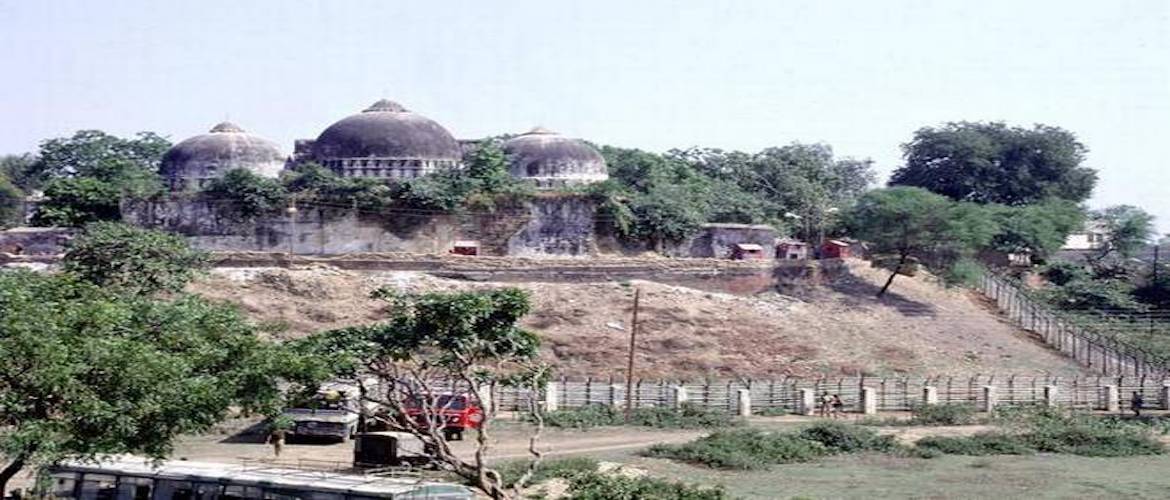Ayodhya: Seeking Closure
November 13, 2019 | Expert Insights

Background
The Ayodhya dispute stretches back to more than a century. Hindus believe that the city in Uttar Pradesh is the birthplace of Lord Rama. It is believed that the birthplace of Rama was demolished by Emperor Babur who erected a mosque in the place of a temple. On December 22, 1949, between the adoption of the Indian Constitution and its formal entry into force, a number of idols were smuggled into the Mosque and planted in the central dome of the Masjid. Subsequently, several suits were filed staking ownership to the site. By the 6th of December 1992, the Masjid was destroyed during a political rally which turned into a riot.
The judges of High Court pronounced a verdict which said that the land had to be divided into three parts: 1/3 going to the Ram Lala represented by Hindu Maha Sabha, 1/3 going to Sunni Waqf Board and remaining to Nirmohi Akhara.
Analysis
On November 10th, five judges of the Supreme Court bench headed by Chief Justice Ranjan Gogoi vacated previous decisions and ruled that the 2.77 acres of land in the legendary city of Ayodhya would be handed over to a trust to build the Hindu Temple. It was also ordered to the government to give alternate 5 acres of land to Sunni Waqf Board to build the mosque.
For 70 years since independence, the case has played a crucial role in redefining and shaping Indian politics. According to the Supreme Court, the genesis of the dispute spanned four distinct legal regimes – that of Vikramaditya, the Mughals, the British and now Independent India. Despite the acknowledgement of the historical wrongs, and having recognized a body that has done an offence against the rule of law, the victims of the cycle were awarded five acres of land in the vicinity of Ayodhya.
The key observations made in September 2010 affirmed that the disputed spot was the birthplace of Lord Ram, that the Masjid was built after the demolition of a Hindu temple and that it was not built accordance with the tenets of Islam. On Nov 9th, the verdict cited a report by the Archaeological Survey of India as the evidence that the remains of a building 'that was not Islamic’ were beneath the structure of the demolished Babri Mosque. The Supreme Court also noted that the Sunni Central Waqf Board has not been able to prove ‘continued undisputed and exclusionary possession’.
India has many cities that have been built on the ruins of other cities and religious places. Many Muslims are worried if the verdict will set a precedent but the bench quoted the Places of Worship Act 1991which was passed to "preserve the religious character of every place of worship as it existed on 15 August 1947." The Act, however, held a specific exemption for the Ram Mandir-Babri Masjid dispute as the matter was already before the courts.
Raising questions on the historic judgment pronounced by the Supreme Court, President of All India Majlis-e-Ittehadul Muslimeen (AIMIM) Asaduddin Owaisi said, "Like the Muslim Personal Law Board, we are not convinced with the decision. The Supreme Court may be supreme but it is not infallible. Those who demolished the Babri Masjid have been given the task of building a Ram temple by building trust." Although few voices expressed disappointment and injustice, the Muslim community which lost its claim to the disputed site, responded responsibly and with restraint.
Assessment
- The conversion of non– Islamic places of worship into mosques occurred during the Islamic conquests and under historical Muslim rule. In case of Ram Janmabhoomi, although the historical evidence for these beliefs is scant, local traditions hold that a temple to Rama stood at the site. The judgement expresses respect for the discipline of history.
- Similar to the Temple Mount in Jerusalem, the site which had become a flashpoint for religious divisions has finally got an identity according to the political context in India. But unlike in Jerusalem, taking into consideration, secularism, the Indian court has given an alternative place to build a mosque. The court has also considered the safety of Muslims in various parts of India.
- Historically, the Muslims in India had denied links with the Caliphate. While there are questions of survival in the land of their forefathers, the Muslim minority has shown their magnanimity by welcoming the verdict.
- In the new India, with the closure in Kashmir and Ayodhya’s case, and the ruling aligning mostly towards nationalist agendas, India may have diminished its status of secular republic among other nations. But, it is also to be noted that world over, this is the trend, with the world moving into neo-nationalism.
Image Courtesy: The Hindu








Comments